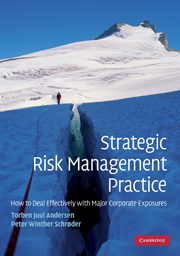Book contents
- Frontmatter
- Contents
- List of abbreviations
- List of figures
- List of tables
- List of boxes
- Preface
- 1 The strategic nature of corporate risk management
- 2 Economic exposures in corporate risk management
- 3 Managing market-related business exposures
- 4 Extending the risk management perspective
- 5 Integrative risk management perspectives
- 6 Current risk management practice and the rise of ERM
- 7 Strategic risk analyses
- 8 Strategic risk management – amendments to the ERM framework
- 9 Strategic risk management
- 10 Postscriptum
- Appendices
- Appendix 1 A strategic responsiveness model
- Appendix 2 Determining the premium on a call option
- Appendix 3 Determining the value of a real option
- Index
- References
8 - Strategic risk management – amendments to the ERM framework
Published online by Cambridge University Press: 05 June 2012
- Frontmatter
- Contents
- List of abbreviations
- List of figures
- List of tables
- List of boxes
- Preface
- 1 The strategic nature of corporate risk management
- 2 Economic exposures in corporate risk management
- 3 Managing market-related business exposures
- 4 Extending the risk management perspective
- 5 Integrative risk management perspectives
- 6 Current risk management practice and the rise of ERM
- 7 Strategic risk analyses
- 8 Strategic risk management – amendments to the ERM framework
- 9 Strategic risk management
- 10 Postscriptum
- Appendices
- Appendix 1 A strategic responsiveness model
- Appendix 2 Determining the premium on a call option
- Appendix 3 Determining the value of a real option
- Index
- References
Summary
In this chapter the critique of the existing enterprise-wide risk management approaches is extended with the aim of proposing amendments to the ERM frameworks in ways that take account of unexpected and hard-to-quantify strategic risk events. This outlines a suggestive strategic risk management paradigm that incorporates existing risk management practices into corporate strategy-making processes, while ensuring an appropriate balance between restrictive central management control systems and flexible response capabilities.
The relationship to corporate strategy
The various ERM frameworks do not establish a convincing link between the proposed formal risk management practices and the dynamic corporate strategy-making processes for framing strategic direction and adjusting operational objectives. The ERM frameworks are preoccupied with various ways in which corporate management can successfully achieve and fulfil predetermined strategic goals. Furthermore, it is common practice in many companies to consider risk management activities and the corporate planning process as two entirely separate management processes. This might be ascribed to the fact that a primary concern of current risk management approaches in many companies is to obtain protection against potential downside effects, while realizing significant cost savings. Accordingly, risk management is typically not perceived as an integral part of strategic management considerations or as part of the creation of new business opportunities, which is a central aim of dynamic strategy-making. Yet, many of the key components within the formal risk management cycle are comparable to central elements of the strategic planning process (Figure 8.1).
- Type
- Chapter
- Information
- Strategic Risk Management PracticeHow to Deal Effectively with Major Corporate Exposures, pp. 178 - 199Publisher: Cambridge University PressPrint publication year: 2010



